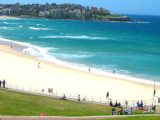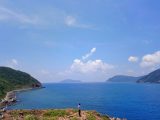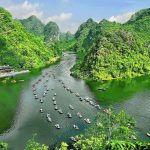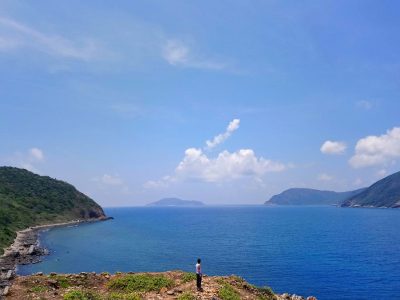Ha Giang Vietnam – the land at the northernmost tip of the country – is a destination that tourists absolutely love. On a tour of Ha Giang, you’ll get to admire unique landscapes as well as the most vibrant seasons of flowers. In addition, you’ll discover the beautiful culture of the ethnic minorities. If you’re planning a self-guided trip to Ha Giang, let’s explore the Ha Giang travel experiences in the article below! We’re sure you’ll have the most perfect Ha Giang itinerary.
Don’t miss this article: The latest self-guided Vietnam travel experiences that travel enthusiasts are hunting for.
1. General Introduction to Ha Giang
Ha Giang is a high-altitude mountainous region located at the northernmost point of Vietnam. It is approximately:
- Hanoi: 274 km away.
- Ho Chi Minh City: 1,743 km away.
- Da Nang: 1,013 km away.
Ha Giang’s terrain is rugged with many majestic mountain ranges averaging 800m to 1,200m in height. Because of this challenging terrain, Ha Giang has many unique mountain passes and slopes. Some famous passes that captivate backpackers include: Nine-Loop Pass, Bac Sum Pass, Tham Ma Pass, and Ma Pi Leng Pass.
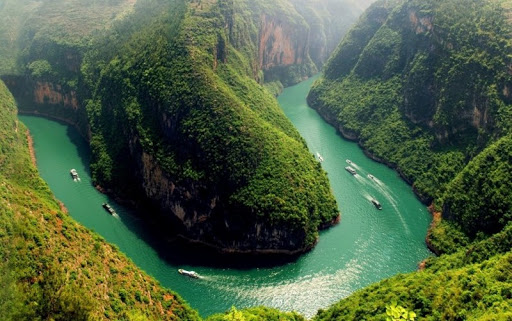
The tour to explore Ha Giang – Dong Van Karst Plateau (Image: Internet).
In addition to the winding slopes, Ha Giang also captivates tourists with other famous landmarks. Among them, my favorites are: Dong Van Karst Plateau Global Geopark, and the terraced rice fields on Hoang Su Phi peak. Furthermore, when you come to Ha Giang, you’ll also get to admire the romantic white season of buckwheat flowers and the beautiful, muse-like Nho Que River. A self-guided trip to Ha Giang will surely bring you the most wonderful experiences if you can combine these destinations together. Let’s explore more details about Ha Giang tourism!
2. When to Go for a Self-Guided Trip to Ha Giang?
Ha Giang has a tropical monsoon climate with an average temperature of 23°C. In the rainy season, Ha Giang has lower, colder temperatures with a lot of rain. In the dry season, the weather is milder and sunnier.
Even though the climate can be harsh and changes frequently, Ha Giang still attracts tourists at any time of the year. This is because, in both the sunny and rainy seasons, Ha Giang has its own unique beauty that enchants tourists. Therefore, you can travel to Ha Giang on your own whenever you are free. Additionally, if you want to check out the flower seasons in Ha Giang, you should visit during these times:
- Buckwheat flower season: According to our travel experience, you should come to Ha Giang from the third week of October to early November for the most beautiful blossoms.
- Yellow mustard flower season: This is most beautiful and vibrant around December. So, come check out the yellow mustard flowers during this time. Some of the most beautiful blooming locations are: Quyet Tien, Pho Cao, and Sung La.
- Plum and peach blossom season: Most beautiful around March. Get a good camera ready for some awesome photos!
- Ripe rice season: The time when the rice turns golden on Hoang Su Phi peak is around September. If you can arrange the time, come check out this fragrant, golden rice field!
3. How to Get to Ha Giang
Using a plane for a self-guided trip to Ha Giang
If you are in a province far from Ha Giang, you can take a plane to Hanoi first. Then, you will travel from there to Ha Giang.
Airlines all have flights from other provinces to Noi Bai Airport in Hanoi. Therefore, you can book tickets directly through the websites of Vietnam Airlines, Bamboo, Vietjet, etc., with prices ranging from 500,000 to 1,200,000 VND. Airfare will vary depending on the time, airline, and route. According to our Ha Giang travel experience, you should book your ticket at least 1 month in advance to get a cheaper price. You can also look for “0 VND” airfare deals to save a significant amount of money.

Ha Giang travel tip: book a plane ticket 1 month before your journey (Image: Internet).
Note: Directions from Noi Bai Airport to Ha Giang: After landing at Noi Bai Airport, you can choose one of the following transportation options to get to Ha Giang:
- Motorbike: You will travel nearly 300km along National Highway 32 to reach Ha Giang. This route is quite easy and safe.
- Sleeper bus: This is a reasonable choice if you want to rest after your flight to Hanoi. You just need to take a nap and you’ll arrive in Ha Giang. The cost of a sleeper bus is also very cheap, only about 200k.
- Coach bus: This is a mode of transportation chosen by many self-guided tourists. The journey by coach bus takes about 6-7 hours. A small tip is to eat a light snack before getting on the bus to avoid motion sickness.
Check out the article: Self-guided Na Hang Tuyen Quang travel: experiences, itinerary & costs when you want to have a wonderful exploration trip.
Coach bus / Sleeper bus
If you are in the areas around Ha Giang, you should take a coach bus or a sleeper bus. These are two very popular modes of transport for self-guided tourists. You can book tickets by calling the bus company directly or booking through travel agencies.

Ha Giang tour: travel comfortably with a high-quality sleeper bus (Image: Internet).
Below are some reputable and quality bus companies you can consider:
- Hai Van bus: 1900 6763.
- Bang Phan bus: 0917 898 898.
- Ngoc Cuong limousine: 0904366279 – 0982295279.
- Hung Thanh bus: 0988.287.741 – 0989.416.416.
Note: The travel time is about 6-7 hours. If you get motion sickness, take an anti-nausea pill about 30 minutes before departure. Don’t forget to eat a light snack so you don’t get hungry before getting on the bus!
Motorbike backpacking
Motorbike backpacking is also a favorite way to travel to Ha Giang. You should note the following:
- Be in good mental and physical health before starting the journey.
- Thoroughly check the vehicle’s mechanics and brakes before you go.
- Don’t forget to fill up the gas tank.
- Bring a travel map if you don’t know the way.
- Bring enough light snacks and water for the entire journey.
- You should go on a self-guided motorbike trip to Ha Giang in a group to support each other throughout the journey.
Note: If you’re not a confident rider or don’t want to go on a motorbike tour alone, check out the motorbike tour to conquer Ha Giang to experience this exciting feeling!

Traveling in Ha Giang by motorbike (Image: Internet).
4. Transportation in Ha Giang for Self-Guided Trips
Taxi
Like other cities, Ha Giang also has taxis for you to use on your self-guided trip. If you are enjoying your trip with family or a large group, you should use a taxi for quick and convenient travel. If you are traveling alone, you should consider it carefully as the cost is quite high.

Ha Giang tour: if you travel in a large group, you should use a taxi (Image: Internet).
Some reputable and quality taxi companies you can consider are:
- Thanh Cong Taxi: 0219 3 826 826 – 0219 3 23 23 23.
- Mai Linh Taxi: 0219 3 25 25 25.
- Son Dan Taxi: 0219 386 1861.
- Truong Xuan Taxi: 0219 386 0860.
- Ha Giang Taxi: 0219 3 82 82 82.
Renting a car with a driver for a self-guided trip to Ha Giang
This form of transportation is similar to a taxi but is more convenient. You can rent a car through a travel agency to get enthusiastic advice and the best support. Or you can book directly through car rental businesses.

Ha Giang tour: you can travel by car with a driver if you are not familiar with the roads (Image: Internet).
The advantage of this option is that you will receive advice on the most suitable and convenient itinerary. More importantly, you can fully calculate the travel costs for the entire journey. Because of these advantages, if you’re on a self-guided trip to Ha Giang with a group of 4 or more, Viet Travel Guide recommends renting a car with a driver to save money and have the most enjoyable Ha Giang tour.
Motorbike – the most flexible mode of transportation on a self-guided trip to Ha Giang
Motorbike backpacking to explore Ha Giang is definitely a wonderful experience for you. With this Ha Giang motorbike trip, you will get to challenge yourself on the challenging mountain passes. The most worthwhile passes and slopes to challenge yourself on a self-guided Ha Giang trip are: Nine-Loop Pass, Bac Sum, Tham Ma Pass, and Ma Pi Leng Pass. In addition, you will also get to admire the beautiful natural scenery throughout your motorbike journey.

Ha Giang tour: self-guided motorbike backpacking to explore Ha Giang (Image: Internet).
Don’t forget to check in at the immense flower gardens blooming on the mountainsides. How wonderful it would be to “ride” your motorbike up Chieu Lau Thi peak. And then, from an altitude of over 2,402m, you will get to admire the beautiful, dream-like scenery at the foot of the mountain. A motorbike journey to conquer Ha Giang will surely make your trip more exciting.
Note: You can rent a motorbike at the hotel where you are staying for convenience.
- Motorbike rental price: 100k – 150k/day.
5. Top Tourist Attractions in Ha Giang
Lung Khuy Cave – an attractive destination on a self-guided trip to Ha Giang
Lung Khuy – the most beautiful cave in Ha Giang – is the first place you should explore on your upcoming self-guided trip. From Tam Son town, Quan Ba district, you drive about 5km to reach Lung Khuy Cave. After arriving, you park your bike and walk into the cave to see the pristine beauty of this millions-of-years-old cave with your own eyes.
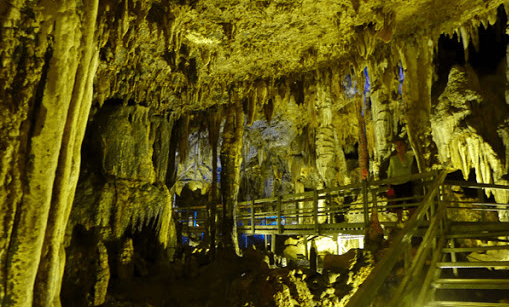
Visiting Lung Khuy Cave on a Ha Giang tour (Image: Internet).
When you enter Lung Khuy, a dark cave over 1,000m deep appears before your eyes. The most impressive thing about Lung Khuy Cave that we wants you to observe carefully is the system of strangely shaped stalactites and gigantic dark yellow stone pillars. In addition, Lung Khuy Cave is also associated with a romantic legend about the love of a Hmong boy and girl. If you have the opportunity to travel to Ha Giang, come explore Lung Khuy Cave and listen to the Hmong people tell this romantic story!
Tham Ma Pass – a beautiful motorbike backpacking route on a self-guided trip to Ha Giang
Your self-guided trip will be wonderful if you ride around Tham Ma Pass – the most famous slope in Ha Giang. By conquering Tham Ma Pass, you not only get to admire the magnificent green natural scenery on both sides of the road, but you also get to challenge yourself on the winding, serpentine road. When you finish the Tham Ma Pass, a peaceful scene of Pho Cao will appear before your eyes.

Conquering Tham Ma Pass on a Ha Giang tour (Image: Internet).
Note: You should only go motorbike backpacking to conquer Tham Ma Pass on dry, sunny days. This will make the road easier and safer for you.
Bac Sum Pass
The next destination on your self-guided Ha Giang motorbike tour is Bac Sum Pass. Bac Sum Pass is a mountain pass located on National Highway 4C that stretches from Vi Xuyen district to Quan Ba. With its characteristic winding and zigzagging road, Bac Sum Pass is compared to a snake “writhing” in a vast sea of sky. Along the Bac Sum Pass, you will not only admire the deep green forests and floating clouds, but when you look up, you will also find the Twin Mountains standing majestically against the blue sky. After stopping at the end of Bac Sum Pass, Quan Ba Heaven’s Gate will appear before your eyes. At the end of the road at Quan Ba Heaven’s Gate, don’t forget to look back at your spectacular journey across Bac Sum Pass one more time! This will surely be a memory that will be forever etched in your mind.
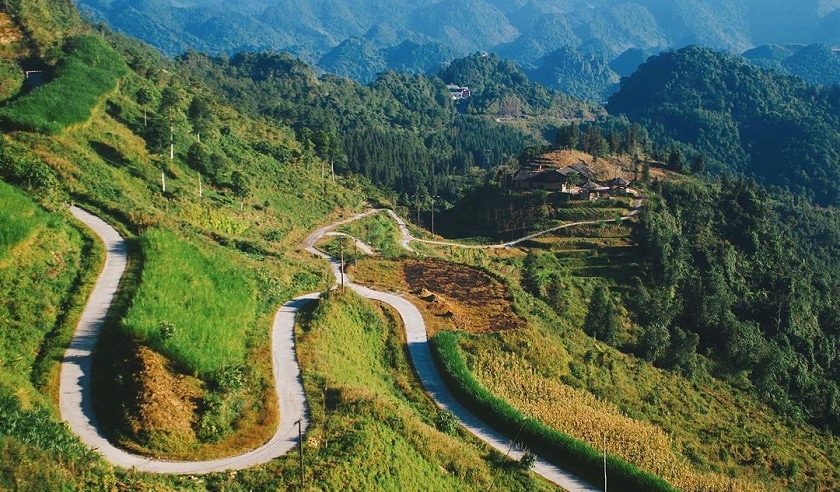
Motorbike backpacking to admire the scenery on the Bac Sum Pass road on a Ha Giang tour (Image: Internet).
Ma Pi Leng Pass
Your self-guided Ha Giang trip will not be complete if you miss the Ma Pi Leng Pass. Your journey to conquer Ma Pi Leng will be about 20km long with the most rugged road in Ha Giang. Along the way to conquer Ma Pi Leng Pass, you will be able to see the sharp, pointed “cat-ear” limestone mountain ranges. These mountain ranges are so sharp that you might mistake them for piercing the sky. In addition, the lush green scenery of the trees on both sides of the road will also lift your spirits.

Ha Giang tour: conquering Ma Pi Leng Pass (Image: Internet).
Most special of all is when you reach the end of Ma Pi Leng Pass, the gentle Nho Que River winding under the mountains will appear before your eyes. Take the opportunity to capture the magnificent beauty of the Nho Que River and Ma Pi Leng Pass to save as a memory! Viet Travel Guide believes that when you backpack on this Ma Pi Leng Pass, you will surely have the most interesting range of emotions.
Nine-Loop Pass
The last slope on your self-guided Ha Giang trip that you should conquer is the Nine-Loop Pass. It gets its name because of its “specialty” of 9 loops with winding and steep curves. In fact, Nine-Loop Pass is a section of Bac Sum Pass. This slope is the transportation lifeline connecting Pho Cao and Sung La. By conquering Nine-Loop Pass, you will get to admire the most beautiful season of buckwheat flowers in Ha Giang if you go at the right time. Most of all, the feeling of conquering a challenge and overcoming yourself on one of the most treacherous slopes on the Dong Van Karst Plateau is a truly amazing experience that you will want to show off to your friends.

Conquering Nine-Loop Pass on a Ha Giang tour (Image: Internet).
Quan Ba – an attractive destination not to be missed on a self-guided trip to Ha Giang
A self-guided trip to Ha Giang will not be complete if you miss Quan Ba district with its many attractive tourist destinations. On your journey to explore Quan Ba district, you will visit famous landmarks such as:
- Twin Mountains: Also known as Co Tien Mountain. From the top of the Twin Mountains, you will get to admire a beautiful panoramic view of the Dong Van Karst Plateau.
- Quan Ba Heaven’s Gate: This is considered the boundary between heaven and earth. Standing at Heaven’s Gate, you will not only admire a beautiful, charming natural landscape harmonized with clouds and mountains, but you will also feel as if you are touching the clouds floating in the blue sky.
- Nam Dam Village: When you visit this village, you will get to interact with the very friendly and hospitable Dao Cham ethnic people. You can also participate in the special festivals that take place in the village.
- Quyet Tien Market: It would be a mistake to go on a self-guided trip to Ha Giang without participating in the markets. Quyet Tien Market takes place every Saturday. So, if you can arrange your schedule, come explore Quyet Tien Market to discover Ha Giang cuisine!
- Vietnam-China Border Marker: If you have visited Quan Ba district, don’t forget to check in at the Vietnam-China border marker. This marker is located at position 276 in Ta Van commune to 339 in Bat Dai Son village.
- Bat Dai Son: On your visit to Bat Dai Son village, you will meet the Hmong and Dao people. You can interact with them and listen to the legends related to this village!
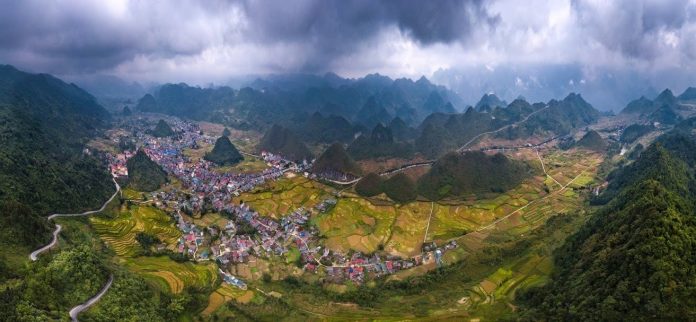
Ha Giang travel experience: exploring Quan Ba district during the market season (Image: Internet).
In addition to its charming natural beauty, Quan Ba district also captivates tourists with its unique markets. Therefore, you should come to Quan Ba to experience the atmosphere of the highland market on your next Ha Giang tour.
Yen Minh
Yen Minh is a small district belonging to Ha Giang province and is adjacent to Meo Vac and Quan Ba districts. From the center of Ha Giang city, you drive about 98km to the Northeast to reach Yen Minh district. As soon as you set foot in Yen Minh district, you will immediately feel the cool European-like atmosphere in this high-altitude region. After getting used to the climate of the border highlands, continue to the vast Yen Minh Pine Forest. There is no experience more wonderful than walking in such a large and straight pine forest. You will surely take a super cool set of photos in this romantic pine forest. So, remember to fully charge your phone to have a blast taking photos!

Visiting and checking in at the Yen Minh pine forest (Image: Internet).
In addition to the pine forest, Yen Minh also captivates tourists with its pristine beauty and the cultural beauty of the ethnic minorities living here. When you come here, you can blend in with the rustic life of the local people, with many exciting activities such as: fishing, cooking rice, bathing in streams, etc. These new experiences will surely make your self-guided Ha Giang trip more interesting.
Note: Based on Viet Travel Guide experience, you can only travel by motorbike to get to this small district because there is no coach bus system operating here yet.
Dong Van Karst Plateau
One destination that any tourist on a self-guided trip to Ha Giang should visit is the Dong Van Karst Plateau. When you set foot on this Karst Plateau, you will see with your own eyes the “cat-ear” shaped limestone mountains stacked on top of each other, reaching a height of more than 1,000m. At first glance, you may wonder how the geology in Ha Giang could have formed like this. To explain the above problem, many geologists began to explore and research. According to the results of these geologists, these “cat-ear” shaped mountains were formed during the development of the Earth’s crust. And it is this development that has helped the Dong Van Karst Plateau become the most attractive tourist destination in Ha Giang.

Dong Van Karst Plateau in Ha Giang (Image: Internet).
In addition to the huge limestone mountain range, the Dong Van Karst Plateau is also home to fossils that are over 600 million years old. Because it is a place that converges many special geological formations, in 2010, UNESCO officially recognized the Dong Van Karst Plateau as a Global Geopark. With such a “precious title,” the Dong Van Karst Plateau deserves to be noted on your upcoming Ha Giang travel itinerary.
Hoang Su Phi
The next place that we wants to introduce to you is Hoang Su Phi district. Hoang Su Phi is located about 100km from the center of Ha Giang city. And it will take you more than 2 hours to get here. Although the distance is a bit far and the travel time is a bit long, once you set foot in Hoang Su Phi, you will surely feel that you don’t want to leave
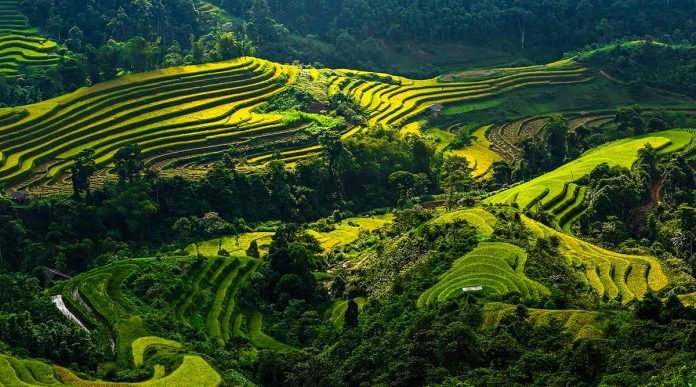
Learning about the culture of the more than 12 ethnic minorities living in Hoang Su Phi (Image: Internet).
When you come to Hoang Su Phi, you will not only get to learn more about the diverse culture of the more than 12 ethnic minorities living here, but you will also have the opportunity to admire the majestic beauty of the terraced rice fields in Hoang Su Phi. The terraced fields here are overlapping and winding, reaching all the way to the blue sky. In addition, you can also challenge yourself on the precarious mountain roads leading to Tay Con Linh and Chieu Lau Phi peaks. The reward for conquering these two mountains is not only the majestic mountain scenery but also the feeling of pride when you overcome your own limits. To receive these two precious “gifts,” you should conquer Hoang Su Phi on your self-guided trip to Ha Giang!
Tu San Canyon – a unique wonder not to be missed on a self-guided trip to Ha Giang
Continuing with your self-guided Ha Giang trip, you should come to explore the unique wonder of the Dong Van Karst Plateau – Tu San Canyon. Tu San Canyon was formed on a cliff over 800m high with a length of 1.7km and a depth of nearly 1km. Because of its height and length, Tu San is known as the deepest canyon in Southeast Asia. Based on the research results of scientists, Tu San Canyon was formed naturally millions of years ago. After a process of erosion, the area was “carved” and became a unique geological wonder as it is today.

Tu San Canyon, the deepest in Southeast Asia (Image: Internet).
The first experience you should have when you come to Tu San Canyon is to take a boat and gently glide on the peaceful Nho Que River. With this journey, you will get to admire an incredibly poetic scenery of green mountains and blue water, as well as the towering cliffs on both sides of the river. This excursion in Tu San Canyon will make you feel like you are in some dreamy, non-existent wonderland. Take the opportunity to take many photos to make the most beautiful memories for your Ha Giang trip!
Nho Que River – an attractive tourist destination on a self-guided trip to Ha Giang
The Nho Que River has its source in Nghiệm Sơn mountain, Yunnan, China, and flows in a Northwest-Southeast direction to Ha Giang and Cao Bang.
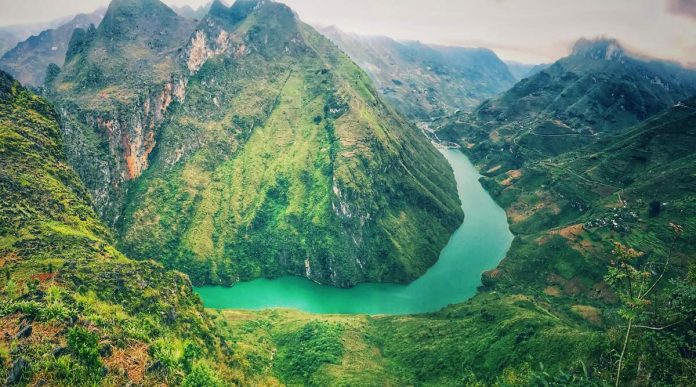
Admiring the poetic beauty and emerald green water of the Nho Que River (Image: Internet).
You can admire the poetic beauty and emerald green water of this river from Ma Pi Leng Pass or Tu San Canyon. The most spectacular and enchanting scenery of the Nho Que River is when it flows through Tu San Canyon. Therefore, on your next Ha Giang tour itinerary, you should combine a boat trip on the Nho Que River to both enjoy the beauty of this river and see the unique geological area – Tu San Canyon – with your own eyes.
Lung Cu Flagpole
A symbolic national landmark located in Ha Giang that you should visit is the Lung Cu Flagpole. To get here, you will have to cross a challenging mountain road that is nearly 200km long.
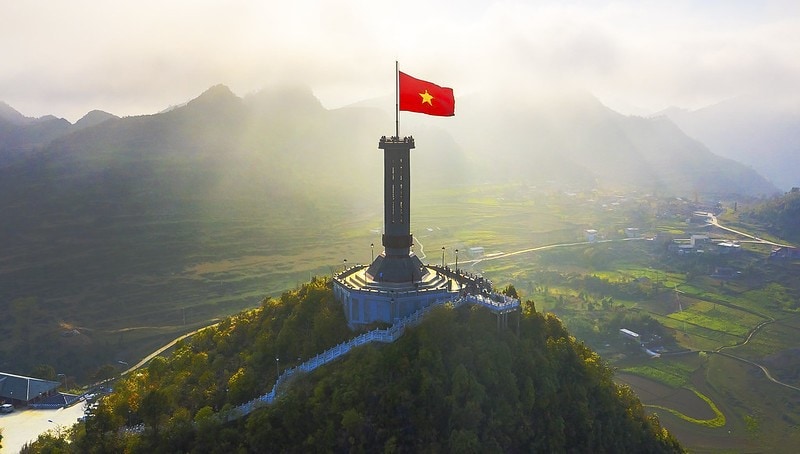
Checking in at the Lung Cu Flagpole in Ha Giang (Image: Internet).
The journey to conquer the Lung Cu Flagpole will take you through winding and slightly steep roads. However, when you arrive, the flagpole with the red flag with a five-pointed golden star flying majestically at an altitude of 1,470m will appear before you. In addition, when you stand at this height, you will also get to admire the majestic panorama of Ha Giang at the foot of the mountain. Don’t miss the opportunity to experience climbing the 140 spiral steps to touch the national flag when you come to Lung Cu! Check in at this flagpole to save this memorable “milestone”!
King Meo’s Palace / Vuong’s Mansion
If you are passionate about exploring places associated with the heroic history of the nation, then immediately note down King Meo’s Palace on your self-guided Ha Giang travel itinerary.
King Meo’s Palace is located in a valley in Xa Phin commune, Dong Van district. It is about 24km from the center of Ha Giang city. The mansion was built starting in 1890 with a budget of 15,000 Indochina silver coins. This “huge” cost is equivalent to 150 billion Vietnamese dong today.
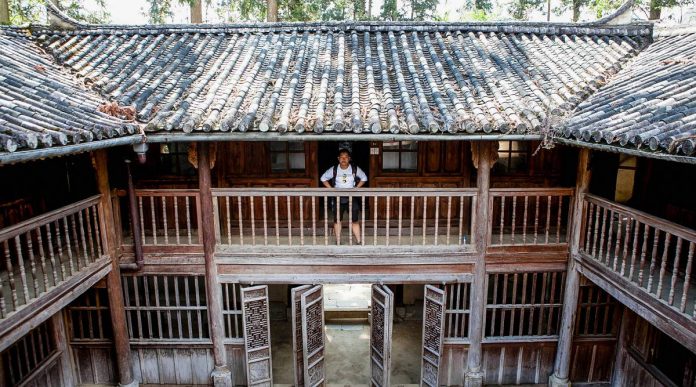
Visiting Vuong’s Mansion, also known as King Meo’s Palace (Image: Internet).
On your tour of King Meo’s Palace, you will get to learn about 3 main areas:
- The Front Palace: Where the soldiers and servants lived.
- The Middle and Back Palaces: Where the children and grandchildren of the Vuong family lived and worked.
You should visit King Meo’s Palace to admire this ancient and magnificent architectural work. This tour will surely enrich your knowledge of the nation’s history.
6. What to Buy as a Gift on a Self-Guided Trip to Ha Giang?
- Dried meat (thịt gác bếp).
- Shan Tuyet tea.
- Ha Giang sausage.
- Corn wine.
- Mint honey.
- Buckwheat lam cake.
- Gia Dui Xin Man rice.
- Seedless persimmon.
- Bac Quang orange.
- Forest ba kich (a medicinal herb).
- Docynia fruit (táo mèo).
7. Some “Cool” Hotels and Homestays in Ha Giang
- Rock Garden: Approximately 350k – 700k.
- Ha Giang Cozy Hostel: Approximately 200k – 500k.
- The Art – Golden Jungle House: Approximately 400k – 900k.
- Ha Giang Guesthouse: Approximately 150k – 500k.
8. Suggested 3D2N Ha Giang Exploration Itinerary
- Day 01: Hanoi – Quan Ba – Yen Minh
- Morning: Check in to the hotel, enjoy Ha Giang specialties, and rest before starting to explore Ha Giang.
- Noon: Have lunch. Travel to Quan Ba and Yen Minh. Visit Twin Mountains. Check in with the charming natural scenery. Visit Lung Tam linen weaving village.
- Evening: Have dinner. Travel to Nam Ban. Free time for fun or rest.
- Day 02: Quan Ba – Yen Minh – Dong Van Plateau – Lung Cu Flagpole
- Morning: Enjoy Ha Giang specialties. Travel to visit the following places: Pho Cao, Sung La, King Meo’s Palace. Check in at the Lung Cu Flagpole.
- Noon: Enjoy a delicious lunch in Lung Cu. Visit Lo Lo Chai village. Learn about the culture and life of the Lo Lo people. Enjoy a fragrant cup of coffee at Cuc Bac cafe. Check in at Cuc Bac cafe with its “cool” view.
- Evening: Return to Dong Van town to rest. Have dinner with Dong Van specialties. Free time to explore the beauty of Dong Van.
- Day 03: Dong Van – Ma Pi Leng – Meo Vac – Hanoi
- Morning: Have breakfast. Take a walk and visit Dong Van Old Quarter. Learn about the lives of the local people and the H’mong, Lo Lo, Tay, and Nung ethnic minorities. Conquer Ma Pi Leng Pass, the Happiness Road. Take a boat to admire the Nho Que River and Tu San Canyon.
- Noon: Have lunch. Get on the bus to return to Hanoi.
9. Ha Giang Travel Q&A
- What are the beautiful flower seasons in Ha Giang?
- Buckwheat flower season: October-December.
- Orange chrysanthemum flower season: October.
- Yellow mustard flower season: Late December.
- Peach and plum blossom season: March.
- Bombax ceiba flower season: March-April.
- Does Ha Giang have a train station or airport?
- To date, Ha Giang still does not have an airport or a train station. Therefore, if you are far away and want to travel to Ha Giang by plane or train, you should book a ticket to Hanoi first. Then, from Hanoi, you can take a sleeper bus or coach bus to Ha Giang. Or, motorbiking from Hanoi to Ha Giang is also a very interesting experience for you.
- In which districts are the markets held?
- Ha Giang has many unique markets that take place every week. The markets are held throughout the villages and districts. The most typical are the markets held in Quan Ba and Dong Van districts.
- How much does a self-guided trip to Ha Giang cost?
- You can estimate the cost of a self-guided trip to Ha Giang if you have a specific itinerary. So, you should create the most detailed itinerary for your own exploration of Ha Giang. Some basic costs for a Ha Giang trip are:
- Transportation costs to Ha Giang: Plane/coach bus/sleeper bus ticket.
- Transportation costs in Ha Giang: Motorbike rental/gas/car rental with a driver/taxi.
- Accommodation costs: Depends on where you stay.
- Food costs: You can estimate based on the menu you planned in your itinerary.
- Sightseeing costs: Depends on the places you visit.
- Contingency costs.
- You can estimate the cost of a self-guided trip to Ha Giang if you have a specific itinerary. So, you should create the most detailed itinerary for your own exploration of Ha Giang. Some basic costs for a Ha Giang trip are:
Note: Some places with entrance fees in Ha Giang:
- Boat on the Nho Que River: 100k/person.
- Vuong’s Mansion: 20k/person.
- Lung Cu Flagpole: 25k/person.
- Lung Khuy Cave: 50k/adult ticket, 20k/child ticket.
- Pao’s House: 10k/person.
10. Some Notes and Experiences You Need to Know for a Self-Guided Trip to Ha Giang
- If you want to have interesting and new experiences, you should explore Ha Giang by motorbike. And to ensure safety, you should go in a group or on a group tour.
- You should choose clothing that is suitable for the weather and the places you visit. The temperature in Ha Giang is quite low. Therefore, when you are on a self-guided trip to Ha Giang, you should wear clothes that will keep you warm.
- Don’t forget to have a raincoat ready in your trunk for when it rains!
- Prepare a detailed Ha Giang exploration itinerary to ensure your tour goes smoothly.
- You should find a few alternative spots in case your planned destination is not open or there are problems with the road.
- You can book a tour with a travel agency if you don’t have time to create an itinerary.
- Pack all the necessary items for your self-guided trip to Ha Giang. You should bring: clothes, a jacket, glasses, hats, shoes, sunscreen, a raincoat, personal medication, personal items, etc.
- Bring enough cash to use to avoid theft or losing it.
- You should be quiet and dress modestly when visiting sacred places in Ha Giang.
- You should bring a portable charger to use when your phone runs out of battery.
- If you are traveling to Ha Giang in a large group, you should rent a car with a driver to save money and have more control over your travel and sightseeing time.
- You can choose to go on a group tour instead of a self-guided trip to save money and effort.
- Leave the areas you visit in their original state. Do not cut down trees, litter, etc.
- Choose reputable shops when you buy specialties as gifts. And don’t forget to check the prices before you buy so you don’t get “ripped off”!
- You can prepare some candy and snacks to give to the ethnic children. They will be very fond of you.

